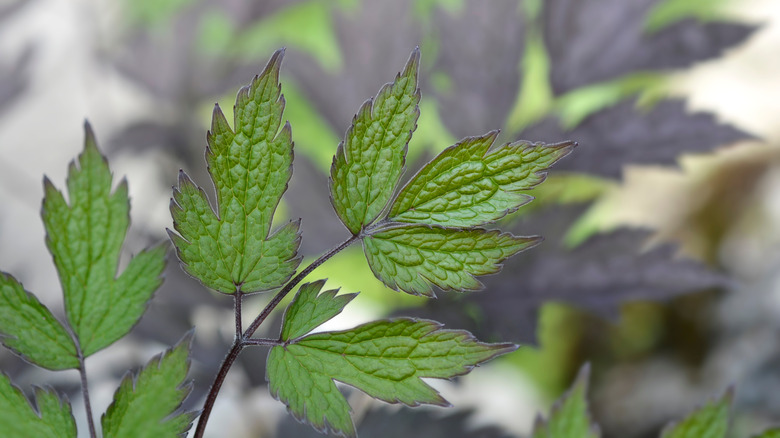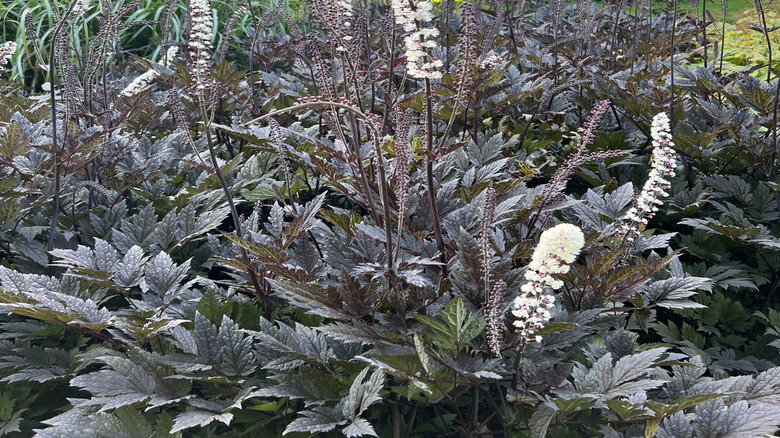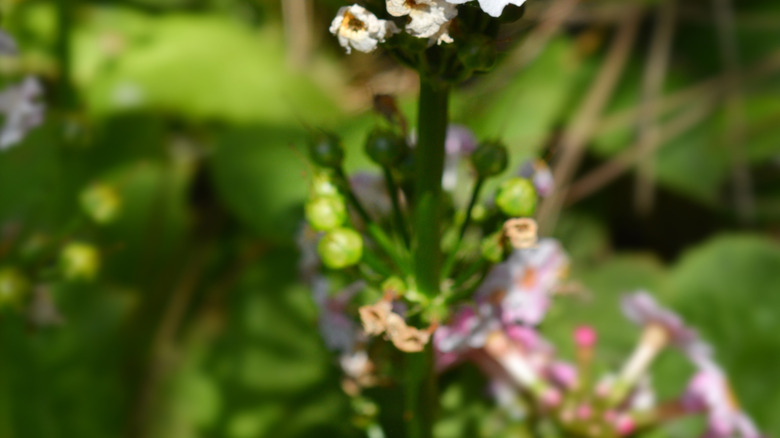The Striking Perennial Plant That'll Grow Tall And Lush In Your Shade Garden
Looking to plant some perennials on your property? Or maybe you're trying to grow a flourishing shade garden. Hillside Black Beauty (Actaea simplex) is one unconventional but striking pick that should definitely be on your radar. Known for its fern-like leaves that range from emerald green to dark purple and its fragrant white flowers, this shade-loving perennial grows anywhere between 4 and 6 feet tall, including the flower spikes, and will add fullness to any landscaping project. It's suitable for USDA hardiness zones 4 through 8 and relatively easy to grow, making it a good option for newer gardeners. (As a note, this plant is sometimes called snakeroot or bugbane, the latter of which is a reference to its insect-repelling properties. However, don't be fooled by its myriad nicknames; these are all the same plant.)
Hillside Black Beauty is native to North America. It's also minimally susceptible to pest infestations and can last for up to 10 years once mature. Plant it in your garden or yard, and you'll be able to enjoy its distinct foliage and its long, spiky, creamy-white blooms, which emerge in the fall, for many seasons to come.
Planting and caring for Hillside Black Beauty
Hillside Black Beauty prefers medium-moist soil and partial to full shade. Although it's easy to grow, the plant requires patience before you can behold its full glory: It can take about three years to reach its mature form. Once it does, though? You'll be left with a low-maintenance flowering perennial that grows tall and wide (and a ground cover plant that deer won't touch). It's a great option for parts of your garden or yard that look sparse and need some dense cover.
To plant Hillside Black Beauty, first choose a spot that's at least somewhat shady and offers some shelter from heavy winds. Strong winds can topple its slender flower stalks. Since this plant can grow up to 4 feet wide, you'll want to space it out so it has plenty of room to spread as it takes root and matures. Water your plant regularly, ensuring that the soil remains somewhat moist; otherwise, its leaves will suffer. Hillside Black Beauty flowers in late summer and early fall — to maximize your potential of seeing those blooms, consider purchasing one at your local garden center and replanting it in your garden earlier in the season. Once established, and with the right care, it will grow big and lush, offering a dark, elegant look with slight color variations throughout the seasons. You can safely cut it back after it flowers or fruits.
How to pair other plants with Hillside Black Beauty
Wondering what other plants will pair well with Hillside Black Beauty? Since it's a tall and wide grower, shorter plants positioned in front of it will complement its height and won't compete with it for sunlight. You might also consider perennials that don't flower or aren't quite as eye-catching — this plant packs a whole lot of look, so it can hold its own as the star of your garden. Additional foliage can add more texture and variety to the garden without competing for attention.
Alternatively, you can go the splashier route and pair your Hillside Black Beauty with white candelabra primroses (Primula japonica). Also stalky and tall-growing, these flowering perennials boast show-stopping white blooms that, though similar in appearance, bloom earlier in the year. Pairing them together gives you floral interest throughout the growing season. They do well in the same soil conditions and USDA hardiness zones as Hillside Black Beauty, too, making these two plants a natural fit. Together, both perennial plants will bring timeless beauty to your garden for years. However, you'll want to position white candelabra primroses somewhere where they'll get slightly more light. These plants need at least partial sun to truly thrive.


